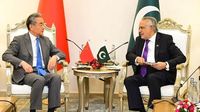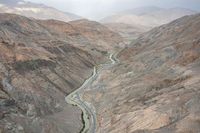On August 21, 2025, Islamabad became the center of a diplomatic whirlwind as China’s top diplomat, Foreign Minister Wang Yi, led a high-level delegation to Pakistan’s capital. The visit, punctuated by a series of meetings with Pakistan’s top leadership—including President Asif Ali Zardari, Prime Minister Shehbaz Sharif, and Deputy Prime Minister and Foreign Minister Ishaq Dar—signaled a renewed vigor in the decades-old China-Pakistan partnership. The agenda? Deepening friendship, strengthening strategic communication, and, most notably, accelerating the next phase of the China-Pakistan Economic Corridor (CPEC), a cornerstone of Beijing’s Belt and Road Initiative (BRI).
According to Xinhua, Wang Yi’s meeting with President Zardari set the tone for the visit. China, he said, is “willing to work with Pakistan to deepen traditional friendship and strengthen strategic communication.” It was a message echoed throughout the day as both nations reaffirmed their commitment to what they call an “All-Weather Strategic Cooperative Partnership.” The phrase, often repeated in official communiqués, carries real weight in a region where alliances are tested by shifting geopolitical sands.
The centerpiece of the talks was CPEC—a sprawling network of roads, railways, power plants, and industrial zones connecting China’s Xinjiang region to Pakistan’s Arabian Sea port of Gwadar. The initiative, which has drawn more than $65 billion in Chinese investment, is not just about infrastructure. As reported by Associated Press and investinglive.com, it’s a strategic lifeline for Pakistan’s struggling economy and a key plank in China’s global ambitions.
But CPEC is evolving. Both sides have now agreed to launch what they’re calling “CPEC 2.0.” While the specifics remain under wraps, officials described the new phase as focusing on agriculture, industry, and mining. Wang Yi, in his meeting with Prime Minister Sharif, called for “accelerating the construction of the 2.0 upgrade version of [CPEC], focusing on the three major areas of agriculture, industry, and mining,” according to a Chinese foreign ministry readout cited by South China Morning Post. He pledged that China would help Pakistan “comprehensively improve self-development ability” and “enhance resilience for external challenges.”
For Pakistan, the stakes are high. Prime Minister Sharif responded with enthusiasm, expressing a desire for expanded cooperation in “aerospace, information technology, and infrastructure.” He also made a solemn promise: “Pakistan would make a full effort to secure the safety of Chinese nationals and projects from terrorist attacks.” This pledge comes in the wake of a series of attacks on Chinese workers, particularly in the restive Balochistan province, where separatist groups have targeted CPEC projects. According to the Associated Press, Pakistan has stepped up security for these projects amid ongoing economic and security challenges.
The sixth round of the Pakistan-China Foreign Ministers’ Strategic Dialogue, held the same day, brought further clarity to the partnership’s contours. Wang Yi and Ishaq Dar, Pakistan’s Deputy Prime Minister and Foreign Minister, reviewed the “full scope of bilateral relations” and agreed to expand cooperation through fresh CPEC ventures. “The two officials agreed to continue close coordination and communication,” reported Bloomberg. They described the China-Pakistan friendship as “significant for maintaining regional peace and stability.”
That significance is not just rhetorical. As both sides underlined, their partnership is seen as a stabilizing force in a region beset by uncertainty—from Afghanistan’s ongoing turmoil to the simmering tensions between Beijing and New Delhi. The Islamabad talks followed Wang Yi and Ishaq Dar’s recent joint visit to Kabul for trilateral discussions with Afghanistan’s Taliban rulers and came on the heels of Wang’s visit to India, aimed at easing tensions between Asia’s two giants.
During the meetings in Islamabad, the breadth of the China-Pakistan relationship was on full display. Trade, science, technology, agriculture, industry, multilateral cooperation, and people-to-people ties were all on the table. Both countries reaffirmed their commitment to “shared prosperity,” with the “All-Weather Strategic Cooperative Partnership” described as “vital for regional peace, stability, and the shared prosperity of both nations.”
CPEC itself has already transformed parts of Pakistan’s landscape. The construction of the Karakoram Highway—often referred to as the China-Pakistan Friendship Highway—stands as a symbol of the two countries’ enduring ties. The highway, along with new rail networks and power plants, has linked previously isolated regions and brought much-needed energy to Pakistan’s grid. The port of Gwadar, managed by China and envisioned as a gateway to the Middle East and beyond, has become the flagship of the CPEC initiative.
Yet, challenges remain. Security is paramount, as Wang Yi made clear in his meetings with Pakistani leaders. The safety of Chinese nationals has become a sensitive issue, especially after a spate of attacks in Balochistan. “Wang Yi emphasized the need for Pakistan to ensure the safety of Chinese nationals working on development projects,” reported Associated Press. In response, Pakistan has increased security measures, deploying additional forces to protect workers and infrastructure.
Economically, Pakistan is grappling with persistent headwinds. Inflation, currency devaluation, and a heavy debt burden have strained the country’s finances. For Islamabad, the promise of fresh Chinese investment—especially in new sectors like agriculture and mining—offers a potential lifeline. “China will help Pakistan improve self-development ability and resilience against external challenges,” Wang Yi assured, according to South China Morning Post.
Meanwhile, the broader Belt and Road Initiative continues to expand China’s footprint across Asia, Africa, the Middle East, and Latin America. CPEC remains a flagship project, but Beijing’s ambitions stretch far beyond Pakistan’s borders. For Pakistan, being at the crossroads of this grand strategy brings both opportunities and risks.
The second phase of CPEC, according to Pakistani officials, involves setting up new special economic zones—a move aimed at attracting investment, boosting exports, and creating jobs. While details are still emerging, the hope is that “CPEC 2.0” will move beyond infrastructure to spur industrialization and innovation. Prime Minister Sharif’s interest in “aerospace, information technology, and infrastructure” points to a desire to leapfrog into new, high-tech sectors.
As the day’s meetings drew to a close, both sides struck a tone of optimism. “China has always been Pakistan’s most reliable partner and strongest backer,” Wang Yi told Sharif. The sentiment was echoed by Pakistani officials, who lauded the partnership’s role in fostering peace and prosperity in the region.
For now, the specifics of “CPEC 2.0” remain to be seen. But if the flurry of diplomatic activity in Islamabad is any indication, both China and Pakistan are determined to write the next chapter of their partnership—one marked by deeper economic ties, greater security cooperation, and a shared vision for regional stability.
As the dust settles on Wang Yi’s visit, the world will be watching to see whether the promises made in Islamabad translate into tangible progress on the ground. For Pakistan, the stakes could hardly be higher.


